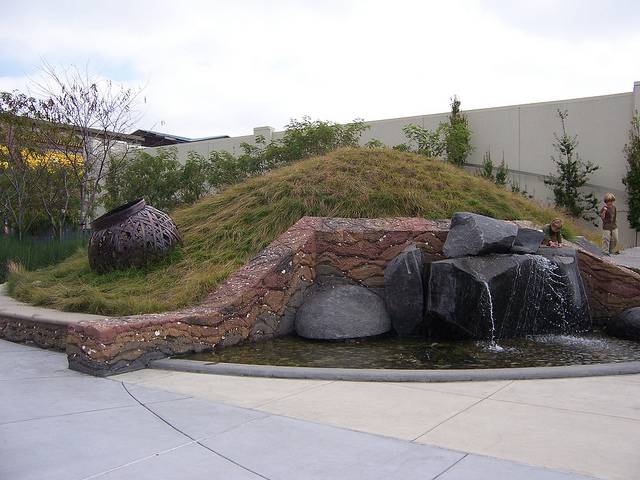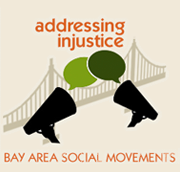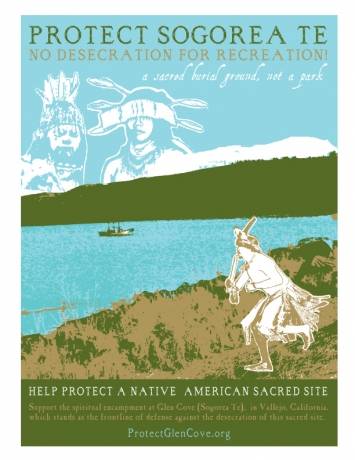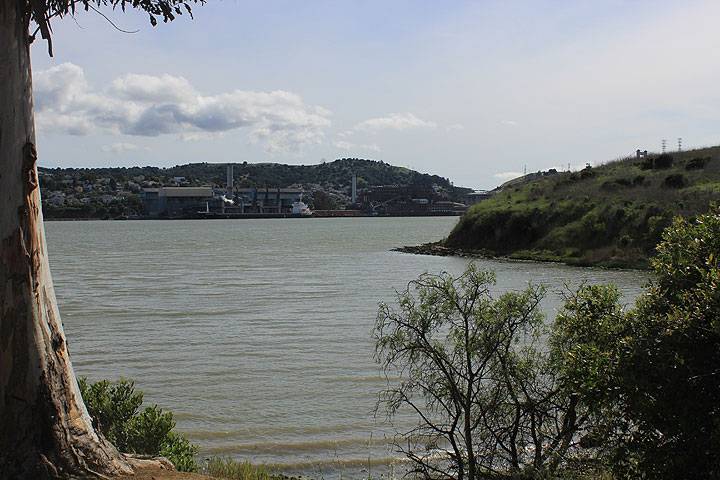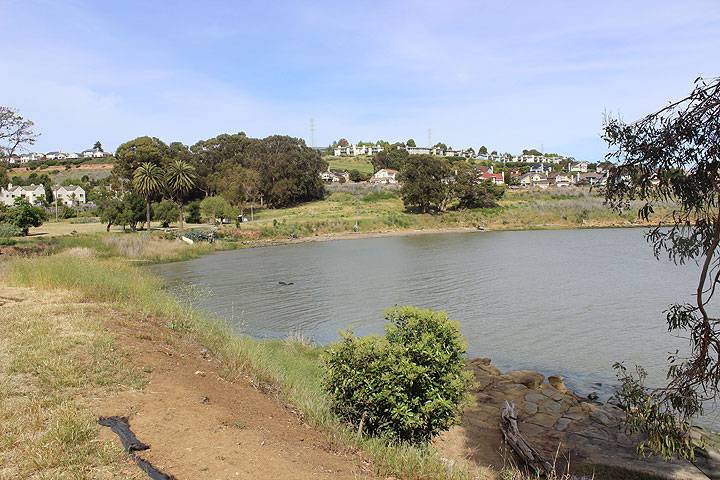Indian People Organzing for Change (IPOC) and the Sogorea Te Occupation
Historical Essay
Written by George Cheng, Mayra Herrera, Paula Kahn, So Jeong Yoon with Marissa Friedman, August 2014
A small monument built at the Bay Street Mall in Emeryville, California, as a symbolic compensation to the Ohlone who originally inhabited the site and built the shellmound which remains buried under the shopping center.
Photo by Wayne Hsieh
| A history of cultural desecration of Native American shellmounds, and the plans for construction of a parking facility on land known to be an ancestral site, led to the creation of an organization called the Indian People Organizing for Change (IPOC) in 1999. The organization seeks to defend and restore sacred sites for communal use through community engagement. In 2011 IPOC occupied the sacred site Sogorea Te on the Carquinez Strait for 109 days to prevent construction at the site. |
When people drive on Interstate 580 near the Bay Bridge and pass the Shellmound St. exit, how many of them are aware of the burial ground they are driving by and probably over? Every year Ohlone descendants and their allies gather at Shellmound Memorial Park on Black Friday to protest the recent desecration of their ancestors’ burial site (E’ville Eye Community News) with the development of the Bay Street Mall over the historic ancestral graveyard known as the Emeryville shellmound.
Native people in the Bay Area continue to resist, a movement galvanized in the 1960s-70s during the Third World Liberation movement. The necessity to protect sacred Ohlone land in the East Bay from development spawned the creation of Indian People Organizing for Change (IPOC). Their efforts to preserve cultural and spiritual identities and defend the sacred nature of land through spiritual walks and encampments can be thought of as an act of self-determination. IPOC’s work responds to centuries of land dispossession, the United States government’s failure to make reparations for the historical displacement of Native Americans, and the lack of United Nations enforcement of international agreements regarding the rights of indigenous people. IPOC’s work also reclaims a spiritual, cultural and communal identity.
For the Ohlone in particular, the shellmounds were community burial grounds. Ohlone and IPOC organizer Corrina Gould clarifies: “Shellmounds are the burial sites of our ancestors. They are not just village sites, but they are always burial sites. There are some villages that didn’t have burials, but all the shellmounds are burial sites. And as the years and centuries went by, these mounds became huge. They became monuments to the people that lived here in the Bay Area.”
Like the fate of many shellmounds in the Bay Area, the site of the Emeryville shellmound has a long history of having been occupied, used, and abused by non-native communities. During the 20th century, the Emeryville shellmound was bulldozed and eventually flattened by multiple industrial development projects. Most recently, notwithstanding Ohlone historical, cultural, and spiritual ties to the land, the shellmound has become the site of the Bay Street Mall.
The understanding of land as sacred to a community—and its dispossession—is an environmental justice issue. The Native American relationship to other living organisms is a spiritual, symbiotic one based on the understanding that we share Earth, as opposed to a possessive, economic, extractive, and destructive relationship with the fruits and diversity of this planet. In the words of Christopher Vecsey:
Indians found their world filled with special spots where power for life was concentrated. These locales were sacred, and they desired to live close to them, where the spirits of nature most often revealed themselves... where their myths took place, where the nature deities were helpful, where conditions for subsistence were optimum. (1980, 25)
According to Luan Marks, “There are immense gaps between those that find the World sacred and those who do not. Sacred Lands and places have been and continue to be destroyed and damaged, despite continued protests. Closing the gap and defending the sacred Lands and Places are monumental tasks“ (Marks 2). In the case of the Emeryville shellmound, the Bay Area Native American community rallied to the defense of the Ohlone and to oppose further economic development of the land.
This urgent need to defend and restore sacred sites for community use is what brought Indian People Organizing for Change (IPOC) together. Stephanie Manning was a preservationist with Berkeley Architectural Heritage when, in the course of her research, she was approached by her neighbor, a UC Berkeley archaeology student, who shared a study with her that had been done in the site of Spenger’s parking lot. The archaeological dig reported that there had been a shellmound on the site and that it was used as a burial site. Stephanie’s interest was piqued, and, due to the ongoing plans for a parking structure to be built there, she was anxious to garner public support. Yet mobilizing supporters proved to be more difficult than she imagined. Even working alongside the International Treaty Council few people stepped forward to help. Stephanie started “The Shellmounder” newsletter as a way of outreach to the larger Native American community. She met Corrina, Johnella, and Perry at Emeryville city council meetings. Corrina Gould & Johnella LaRose found out about bodies being dug up at the Emeryville construction site through their connection with the Inter-Tribal Friendship House, a community space they worked with to preserve Indian identity and culture. Perry, Stephanie, Corina, and Johnella then went on to establish Indian People Organizing for Change (IPOC), an organization which has brought together a community of American Indians as well as non-American Indians to advocate for “social and environmental justice within the Bay Area American Indian community” (Indian People Organizing for Change).
IPOC was created in 1999 with a grant from the Catholic Campaign for Human Development (LaRose). The Community Mobilization Project and the Bay Area Native American community were the primary actors behind the formation of IPOC. IPOC directly addresses the long history of appropriation and destruction of Native American land, culture, means of self-governance, and general way of life, compounded with relocation initiatives imposed by the federal government. The goal of IPOC from the beginning has been to strengthen the connection between American Indians and their traditional culture(s) in ways which fulfill the need to belong to an affirming community (Gould). The organization operates upon the theory that once the needs of a community are met, the community becomes self-sufficient and is then able to support other communities in organizing (Gould). The organizing for sacred land preservation was and continues to be one way in which IPOC works towards achieving these goals.
As a solution-oriented organization the group functions as the eyes and ears of the community, providing an open forum for Indian people to voice concerns and come up with solutions. The organization’s earlier methods of tracking community concerns included making house calls, or door-to-door visits, in which a pair of IPOC members would speak with Native American residents. Taking a page from Cesar Chavez’s farmworker organizing history, IPOC sought to engage community members first and then develop solutions to problems. This approach turns upside down the traditional top-down model of community development and organizing (LaRose).
IPOC also promoted leadership skill development to educate community members about the concepts of sovereignty, self-definition and self-sufficiency. The organization also held monthly gatherings to develop outreach for Indian veterans while also organizing youth to practice outreach with the homeless (LaRose).
In 2005 Corrina had dreams about her ancestors which became the inspiration for IPOC’s involvement in a series of walks for the shellmounds from 2005 to 2009 (Manning). The walks sought to raise awareness about the importance of the sites and why land preservation was so critical. The protection of land is tied directly to the preservation of American-Indian culture and identity as well as honoring the ancestors who have been buried there. In this sense, having the space to practice one’s culture reinforces the identity of the practitioner.
Sogorea Te/Glen Cove 2011
Poster created to raise awareness of and raise money in support of the Sogorea Te Occupation in 2011.
Image: Dignidad Rebelde
Following their earlier shellmound walks, IPOC organized an 109-day occupation and spiritual encampment at Sogorea Te, also known as Glen Cove, on April 14th 2011. The objective of the occupation was to prevent the Greater Vallejo Recreation District from constructing a parking lot and grazing the land. IPOC was able to reach an agreement with the district on the conditions of development. “It originally started off as a 15-space parking lot with overhead lights and we were able to change it to only 2 handicapped spaces with no lights, but when they built it they added in an extra 6 car spaces. Also, we were able to negotiate the material that was used for the pavement, allowing animals to cross more safely” (LaRose).
IPOC’s Sogorea Te occupation remains highly significant for its participants as a means of re-establishing identity through the reclamation of space and history. According to Barbara Voss, “Collective and individual identities are formed in part through patterns of bodily movements that generate knowledge of one’s place in the world and one’s relationship to the social order. Feelings of being “lost,” and “out of place,” or in the right place are practical expressions of this knowledge. Power is thus often materialized through control of space and bodily movement” (Voss, 148). IPOC’s occupation of Sogorea Te challenged the ways in which colonization had transformed spatial relations for over 200 years. The occupied space at Sogorea Te affirmed the IPOC community’s collective identity, fostering a sense of belonging and empowerment among participants.
View from Sogorea Te (Glen Cove) across Carquinez Strait to old C&H Sugar Factory at Crockett, 2014.
Photo: Chris Carlsson
Those who participated in the occupation spoke of dreams transmitted from the ancestors and appearances of protective spirits. According to one participant, “One day I was in so much pain, I really wanted to cry...and I felt a hand touch me on the shoulder and I looked back and there was nobody there, but my leg started feeling better and I could make it through the night...it was really powerful, it was very spiritual” (Bear Warrior).
At the annual anniversary of the occupation participants shared stories, rooted in a newfound sense of purpose and community for its members and participants:
...So that’s how I began to make my connection to the land…just being part of my culture...learning from each other. Everybody began to grow into their role in the community—it was a beautiful experience... [On] the land out here [we] walked on it with no separation—no cities, no buildings, nothing to block us from our connection with the land and that’s where I think the knowledge and wisdom of how to be with one another is embedded in the land (Luta, community member).
Barbara Voss understands that it is “through bodily movement that people are capable of transforming their world by taking social action, for the meaning of a place is produced through the interactions and activities that occur there.” (Voss, 2008) By interrupting the landscape of Sogorea Te for those 109 days, IPOC members combated the false narrative of Ohlone extinction, while simultaneously fighting to preserve and repossess their culture, land, history and identity in the process. According to IPOC founding member Corina Gould, “We all became human again.” (Gould)
Sogorea Te (Glen Cove), 2014.
Photo: Chris Carlsson
Notes
"Bay Radical." : The Shellmound. N.p., Nov.-Dec. 2007. Web. 16 May 2014.
Bear Warrior, Personal interview.
Gould, Personal interview.
Indian People Organizing for Change, 1 Jan. 2010. Web. 1 Apr. 2014.
LaRose, Personal interview.
Luta, Personal interview.
Manning, Personal interview.
Marks, Luan F.M. Natures of the Sacred: On Native North American Sacred Lands and Places. Diss. California Institute of Integral Studies, 2007. San Francisco, CA. Print.
Vecsey, Christopher. 1980. American Indian Environmental religions. In Vecsey and Venables 1980, 1-37.
Voss, Barbara L. The Archaeology of Ethnogenesis: Race and Sexuality in Colonial San Francisco. Berkeley: U of California, 2008. Print.

